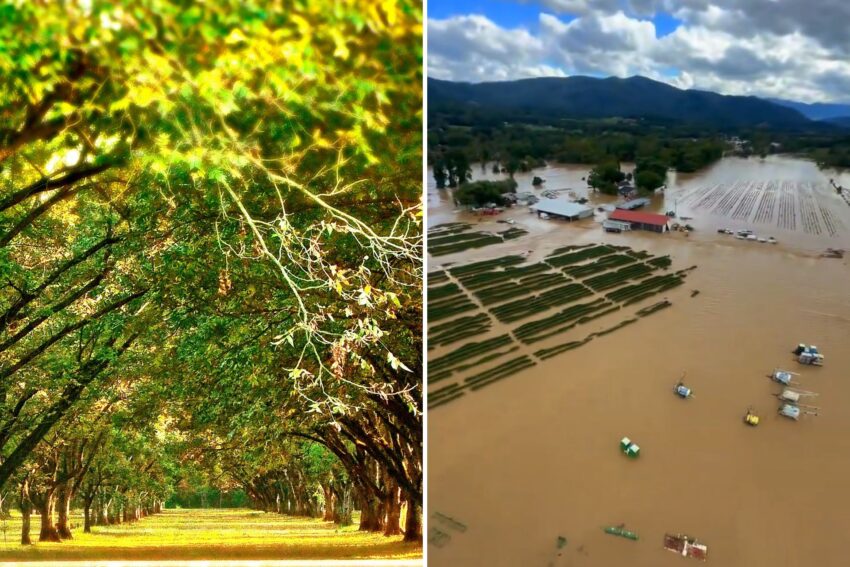Hurricane Helene, which made landfall as a devastating Category 4 storm, has left an indelible mark on the agricultural landscape of the Eastern United States, particularly in regions known for their fruit orchards and perennial crops. Unlike annual crops like corn or soybeans, where farmers can replant the following season, the impact on fruit trees and vineyards could see recovery times stretching over decades.
Officials estimate that Hurricane Helene has led to crop losses in the billions, with the USDA predicting potential insurance payments of up to $7 billion across the Southeast. #AgTwitter
— RFD-TV (@OfficialRFDTV) October 3, 2024
The storm, with its catastrophic storm surges and winds up to 140 mph, has not only uprooted trees but also damaged the soil and infrastructure critical for agriculture.
Here’s a closer look at the ripple effects through various agricultural sectors.
USDA Under Secretary for Farm Production and Conservation Robert Bonnie says the biggest crops hit by Hurricane Helene are corn, soybeans, cotton, peanuts and orchards.
— Jennifer Shutt (@JenniferShutt) October 1, 2024
Of course, corn and soybeans have been significantly impacted, but as previously stated, these can be regrown next year. The same cannot be said for the devastated fruit trees. States like Georgia, known for pecans, and North Carolina, with its apple and peach orchards, are facing profound challenges. Pecan trees have been severely affected, and it takes years to mature before they can produce commercially viable yields. The pecan industry alone might see damages exceeding $1 billion, which could take over a decade to fully recover, considering the time it takes for new trees to mature.
The Appalachians is one of the biggest producers of fruits and vegetables in the nation. And many other farms produce crops, tobacco, or dairy.
Helene’s damage with the flooding she caused in NC and TN could be upwards of 110 billion dollars. https://t.co/uiVDaD6klw
— Mike (@Mike__Gagliardi) September 28, 2024
The wine industry in Virginia and North Carolina, already boutique in scale, has suffered from Helene’s fury. Vineyards require meticulous care and time, with vines taking several years to produce quality grapes after planting. The loss here isn’t just about this year’s harvest but the potential loss of vintages for years to come.
While cotton might not be as perennial, the damage to fields and equipment, coupled with waterlogged soils leading to root diseases, poses immediate and long-term challenges. The flooding caused by Helene’s rains, estimated to bring over 20 inches in some areas, has not only delayed the current harvest but could affect soil fertility and structure for years.
Hurricane Helene has also cast a long shadow over the poultry industry in the Eastern United States, particularly in states like Georgia and North Carolina, which are significant players in the poultry sector. The storm’s fury didn’t just disrupt operations but inflicted substantial damage. Reports indicate that at least two major poultry processing plants were forced to close temporarily due to direct hits by the hurricane, leading to immediate losses in production capacity. Moreover, the storm’s passage disrupted feed supplies and transportation logistics, crucial for the daily operations of poultry farms.
[Video] 'Catastrophic': Georgia suffers significant farming loss after Helene
Source: FOX Carolina https://t.co/9NA90ZbM3y— ⚔️🥷Ninja Nannie🥷⚔️ (@Ninjanannie59) October 3, 2024
The agricultural sector’s economic backbone in these regions has been shaken. From the immediate loss in crop yields to the long-term reduction in land value due to damaged or destroyed orchards, the economic recovery will be slow. Insurance payouts might cover some of the immediate losses, but they rarely account for the years it takes for perennial crops to recover. This couldn’t come at a worse time, with farmers already facing difficult times.
South Carolina farmers face Helene's damage after months of drought and falling prices https://t.co/dnGe03y10n
— Holy City Sinner (@HolyCitySinner) October 3, 2024
Beyond the economic and food supply concerns, there’s an environmental cost. Losing these trees and plants contributes to soil erosion, altering local ecosystems. The resilience of these agricultural areas will depend significantly on environmental management and possibly innovative recovery strategies.
Rural communities, where agriculture might be the primary economic activity, face existential threats. The labor-intensive nature of orchard and vineyard recovery might lead to migration, further straining these communities.
Although the USDA has announced plans to assist, showing that it recognizes the severity of the crisis, the real challenge lies in restoring these agricultural lands to their pre-Helene productivity. Efforts will likely involve not just replanting but soil rehabilitation, water management, and perhaps a re-evaluation of the species of crops grown.
Hurricane Helene has spotlighted perennial agriculture’s vulnerability to extreme weather events. The recovery will be a test of resilience, innovation, and patience as these regions consider a timeline measured not in seasons but in decades.


